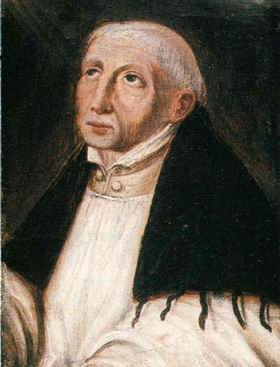
Fr. Thomas Keating writes:
This tradition [in which Centering Prayer stands] was handed on by the Hesychists of Eastern Orthodox tradition, and in particular by the sixth-century Syrian monk known as Pseudo-Dionysius; Meister Eckhart, John Ruysbroek, and the Rhineland mystics of the Middle Ages; the anonymous author of The Cloud of Unknowing in the fourteenth century; later by the Carmelite tradition exemplified by Teresa of Ávila, John of the Cross, Therese of Lisieux, and Elizabeth of the Trinity; and in the last century by Thomas Merton.
Fr. Thomas Keating, Open Mind, Open Heart, 20th anniversary ed. (London: Bloomsbury, 2006), 5.
Who was John (or Jan) Ruysbroeck? He was a Flemish Augustinian Canon who lived in the 13th and 14th centuries. He was beatified in the early 20th century. Ruysbroeck taught that union with God required detachment from all created things and the sacrifice of one’s self-centeredness.
Ruysbroeck completely rejected methods like Centering Prayer. He wrote:
When a man is bare and imageless in his senses and empty and idle in his higher powers, he enters into a rest through mere nature . . . without the grace of God. These people err gravely. They immerse themselves in an absolute silence that is purely natural, and a false liberty of spirit is born from this. Having drawn the body in upon itself, they are mute, unmoving. . . . They mistake these types of simplicity for those which are reached through God. In reality they have lost God…
And in this natural rest one cannot find God, but it certainly leads a man into a bare vacancy, which may be found by Pagans and Jews and all men, how wicked soever they may be, if they can live in their sins without the reproach of their conscience, and can empty themselves of every image and of all activity. In this bare vacancy the rest is pleasant and great. This rest is in itself no sin; for it exists in all men by nature, whenever they make themselves empty. But when a man wishes to practise and possess it without acts of virtue, he falls into spiritual pride and a self-complacency, from which he seldom recovers. And he sometimes fancies himself to have and to be that to which he shall never attain. When a man thus possesses this rest in false quietude, and all loving adherence seems a hindrance to him, he clings to himself in his rest, and lives contrary to the first way in which man is united with God: and this is the beginning of all ghostly error.
Adornment of the Spiritual Marriage, chapter LXVI .
Methods similar to Centering Prayer were known to the saints and mystics of previous eras — and rejected by them. In Ruysbroeck’s day, The Brethren of the Free Spirit taught a quietistic pantheism. Ruysbroeck wrote Adorment of the Spiritual Marriage to combat the errors of the group known as the Brethren (and Sisterhood) of the Free Spirit, particularly as taught by a woman named Bloemardinne.
Bloemardinne and others taught that when one reached union with God, he no longer needed to perform any virtuous acts or even pray. Like the Gnostics, they believed they could indulge their flesh without sin, because of their level of perfection.
In fact, Centering Prayer is more like the practices of those Ruysbroeck opposed than it is like his own practice and teaching.
Connie Rossini
